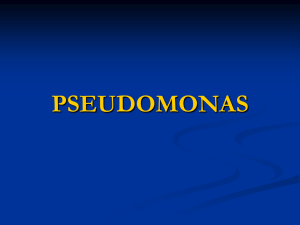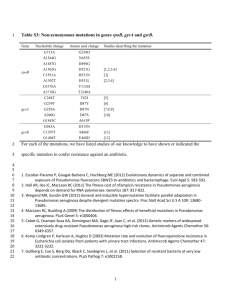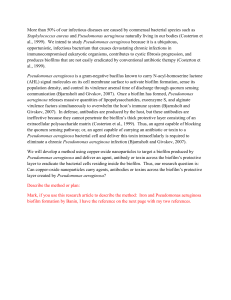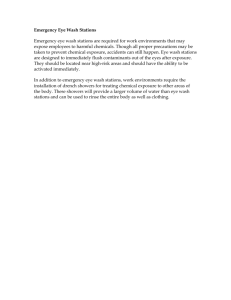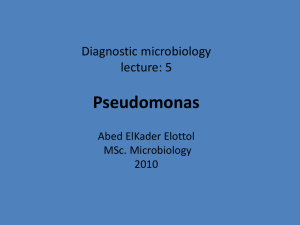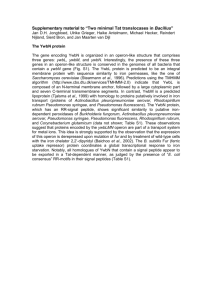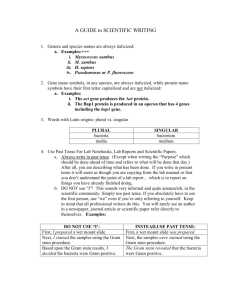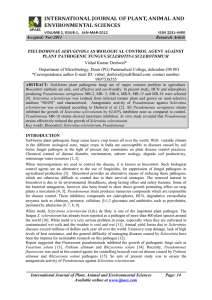Pseudomonas in the Paediatric Intensive care Final P Joannidis
advertisement
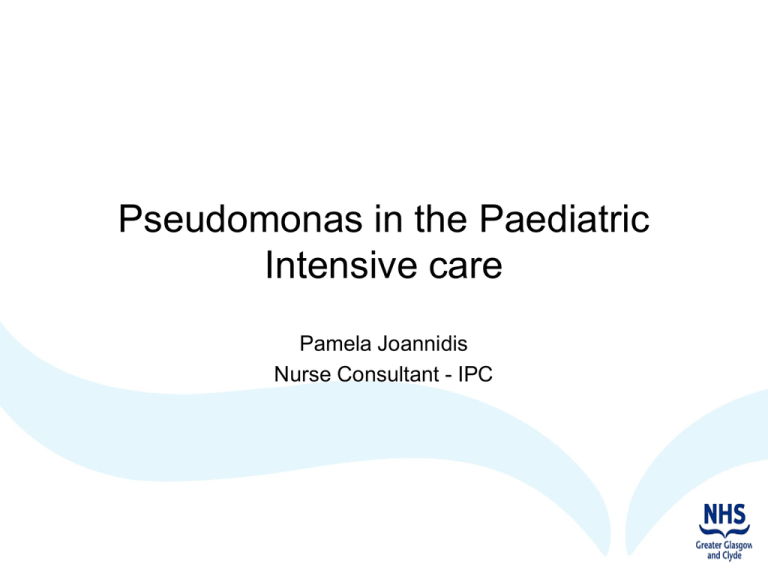
Pseudomonas in the Paediatric Intensive care Pamela Joannidis Nurse Consultant - IPC Learning Outcomes • Pseudomonas in the healthcare setting • An outbreak of Pseudomonas in a paediatric intensive care setting • Prevention and Control: Legislation and guidance Pseudomonas • Gm –ve, aerobic, motile, coccobacillus • Found in soil, water, skin flora and most man-made environments • Normal or hypoxic atmosphere • Opportunistic pathogen of plants and animals • General inflammation and or sepsis • Infection of lungs, kidneys or urinary tract can be fatal Virulence factors • • • • • • Aerobic, Facultative anaerobe Flagellae and pili Cell surface polysaccharides - biofilms Toxins Quorum sensing Antibiotic Resistance Biofilm • Every non-changing non-sterile surface • Attachment of free floating bacteria • Growth via cell division and recruitment Biofilms • • • • • • • • • Self produced matrix Extracellular DNA, polysaccharide and proteins Form on living and non-living surfaces Prevalent in nature, industry and healthcare - showers, water and sewage pipes Switch to biofilm growth mode Marine engineering systems Biofouling of seagoing vessels International space station Dental plaque Water pipes Human body Outbreaks • An Outbreak of Skin Rash Associated With A Spa Bath In A Leisure Centre (Pseudomonas aeruginosa) • An Outbreak of Pseudomonas aeruginosa Infection Caused by Contaminated Mouth Swabs • Outbreak of Pseudomonas fluorescens Bacteremia among Oncology Patients • An Outbreak of Pseudomonas aeruginosa Infection in community hospitals in Japan associated with urinary catheters • NICU, 4 neonates, NI 2012 Risk factors for outbreak • Environmental PA in 12 of 14 studies • 22% infection, mort. 18.2 – 100% • Antibiotics, no.days of antibiotics, blood transfusion, umbilical catheters, IV fluids • Increasing age and false nails • Bottles water • Special feeds preparation area • Molecular typing Pseudomonas aeruginosa outbreaks in the neonatal intensive care unit – a systematic review of risk factors and environmental sources (Jeffries et al , 2012) Northern Ireland 2012 • • • • • • • • Only use the hand wash stations for hand washing Do not dispose of body fluids at the hand wash station Do not wash any patient equipment in hand wash basins Do not use basins for storing used equipment awaiting decontamination Use all hand wash stations regularly Flush taps regularly, either automatically or manually, and keep a record of when they were flushed Report any problems to the infection prevention and control team Use pre-filled single-use bottles for alcohol-based handrubs or cleaning solutions Ensure all staff are properly training Setting the scene •Original site at Garnethill opened 1882 with 58 beds •Royal patronage in 1889 •Designed by John James Burnet, the latest building opened in July 1914 paid by charitable donations. • Hospital currently has 266 inpatient beds, 12 day case beds, and handles approximately 90,000 outpatients, 15,000 in-patients and 7,300 day cases every year Case study: Time line Incident No. 1 • Late August 2007 4 patients with PA (2 in blood cultures) All same strain • Environmental sampling : Tap (2) +ve • Tap(2) is at sink next to index case • September 2007 3 new cases (1 from blood culture) • 3 strains identified • 5th case Actions taken: Environmental screening • • • • • • • • All 6 CHWB (basin, soap nozzles, taps) Water samples from each CHWB Procedure trolleys Bed space floors IV pumps Key boards Ventilator control panels Blood gas analyser Actions taken: Environmental screening • • • • • • • • Microfibre mops, mop buckets Resuscitation trolleys (inside and out) Bottle warmers Taps after domestic clean Taps after estates clean Hands before / after HH Stethescopes Ultrasound machine and gel Actions taken: Audit • Safe Patient Environment Audit • Hand hygiene audit • Domestic Services Review of environmental cleaning Actions taken: Patients • Screening swabs on admission • Consider isolation of patient • Close unit to non-emergency admission Actions taken: Communications • OCT • Parent fact sheets • Staff announcements • Media statement Where did we find it • Patients • Condensate (from +ve patient) • Tap next to +ve patient (but not sink or water) • Other taps, other patients Summary of sampling • • • • • 5 patients had same by PFGE 18PA-2 2 patients had same by PFGE 18PA-4 4 patients had unique PA 1 CWHB had PFGE 18-2 4 CHWB had unique PA Possible routes of transmission • Condensate from the index case tested +ve • Staff admitted to putting this down the CHWB • Trough sink water splashing onto 4 and staff uniform • Staff touch sensor to activate tap Actions • Deep clean of CHWB • Stop environmental sampling! • Strip all CHWB and deep clean with chlorine • Stop using CHWB for condensate disposal • Review of ventilator circuit with manufacturer • Hand hygiene techniques (sensor) • Adjust strength of water flow Incident Summary • Index case +ve 30.07.07 (NPA/ETA) • Condensate from 1 index case only • 5 patients • 1 CWHB tap Guidance in Scotland • The control of Legionella bacteria in water systems. Approved Code of Practice and Guidance (L8) • Water safety for healthcare premises Part A: Design, installation and testing. SHTM 04-01 • Water sources and potential infection risks to patients in high risk units – revised guidance. CEL 08(2013) • Guidance for neonatal units (NNUs) (levels 1, 2 & 3), adult and paediatric intensive care units (ICUs) in Scotland to minimise the risk of Pseudomonas aeruginosa infection from water ( HPS, 2014) Control of Pseudomonas The Six Critical Control Points • The hospital water delivery system • Flushing taps to reduce the risk of pipework system contamination • Preventing direct water usage colonising/ infecting vulnerable patients • Preventing indirect water usage from colonising/infecting patients • Preparedness for clinical incidents and earliest possible detection of any clinical incidents • Prompt investigation and control measure application for any clinical incidents IPCTs Guidance • Set up a water safety group to develop an action plan for each board • Develop separate risk assessments for Legionnaires and Pseudomonas • Ensure correct clean and dirty separation is maintained • Ensure taps and thermostatic mixing valves have been commissioned and routinely validated according to the manufacturer’s instructions Local actions • • • • • • • Engineering controls All CHWB appropriate CHWB cleaned daily, not ‘little used’ No water baths, defrosting milk Sterile water where possible Patient equipment cleaning Hand hygiene and aseptic practices Chief Executive’s Responsibilities As detailed in SHTM 04-01 and CEL 08 (2013) 1;30 the CEO is ultimately responsible for ensuring: • Clinical areas where patients at the highest risk of P. aeruginosa or similar infection have been identified. • Clinical Directors and Senior Charge Nurses of these clinical areas have been informed of the risks and the actions in this guidance needed to prevent P. aeruginosa. • Best practice relating to the use of hand washing facilities is consistently and fully applied. • There is a nominated Responsible Person (Water) for their NHS board. • There are robust systems and documentary evidence of safe water management systems which includes having a Water Safety Group (WSG) a Water Safety Plan (WSP), inclusive of risk assessments and actions to mitigate risks. • A report is provided to the board, at least annually providing assurance Checklist Risk Assessment and identification of actions that are required to reduce or negate P. aeruginosa risks: • An assessment in these clinical areas of the suitability of the water distribution system including design, maintenance and configuration of pipework, provision, location and design of thermostatic control devices, design and layout of hand wash stations i.e. position of sensor, soap, gel and angle of lever on operated tap, identifying unused and under-used outlets and hand wash stations and the unnecessary use of flexible hoses and any containing inappropriate lining materials. Checklist • Confirmation that there are sufficient easily accessible hand wash stations that are all being used or flushed at least daily in all NNUs and ICUs and other recognised clinical units. • An assessment of the clinical practice and ongoing care of invasive devices, cleaning of patient equipment and usage of hand wash stations that could compromise patients. • The sampling and monitoring that needs to be put in place in the event of an outbreak or incident. • Those NHS boards with existing robust water management policies for Legionella will already have in place much of the integral requirements for developing a WSP. Thank you

